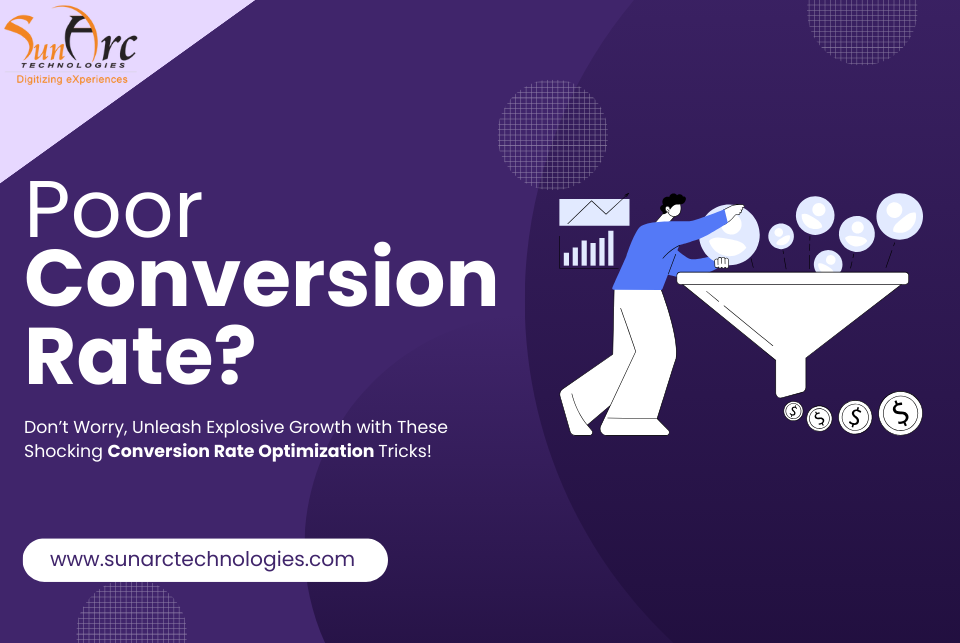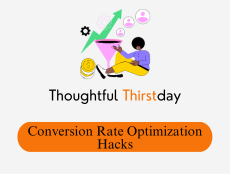“There is a stream of visitors to my E-Commerce website, but there is no conversion. There are Ads that receive clicks, but no purchase is happening; why?”
As an E-Commerce store owner, you always have these questions at the back of your mind. You might search your queries on Google and look for the right answer in your business community but don’t get the desired answer.

Don’t worry; after reading this blog, you will get some ideas, some tips, and motivation, and after applying all the conversion rate strategies, you will experience an improvement in conversion rates.
Well, without prolonging our introduction, let us move on to the main point: “How do you improve conversion rates?”
Let’s get started..!!
What Is a Conversion?
Let’s start by defining what a conversion is. A conversion is a specific action you want your website visitors to take. It can be anything from making a purchase, signing up for a newsletter, filling out a contact form, or even watching a video. Essentially, it’s the desired outcome that aligns with your business goals.
What Is a Conversion Rate?
The conversion rate is an important metric that provides insight into the percentage of visitors who actually take the desired action on your website compared to the total number of visitors. The reason why this performance indicator is so important is because it directly shows how well your website is performing in terms of achieving its goals.
What Is the E-Commerce Conversion Rate?
The term “E-Commerce conversion rate” is specifically used in the context of online stores. The E-Commerce conversion rate is a metric that tells you the percentage of visitors who purchase out of the total number of visitors to your online store. To improve the conversion rates, you must focus on Conversion Rate Optimization (CRO). The main focus of E-Commerce CRO is to improve this metric by applying various strategies.
Average E-Commerce Conversion Rate Benchmarks
Gaining an understanding of industry benchmarks can provide you with valuable insights into how well your website is performing.
Typically, E-Commerce conversion rates fall within the range of 2-3% on average. However, it’s crucial to remember that these numbers can differ greatly based on the industry you’re in, the audience you’re targeting, and the overall quality of your website.
According to the sources, here is a list of countries that have the most average conversion rates.
| Country | Average Conversion Rate |
| The United Kingdom | 4.10% |
| The United States | 2.30% |
| Germany | 2.22% |
| Denmark | 1.80% |
| Netherlands | 1.78% |
| Italy | 0.99% |
Average E-Commerce conversion rates by industry. (Sources)
| Industry | Average E-Commerce Conversion Rate |
| Arts and Crafts | 4.20% |
| Health & well-being | 3.61% |
| Kitchen & home appliances | 2.78% |
| Pet care | 2.05% |
| Fashion, Clothing, and Accessories | 1.47% |
| Sports and Recreation | 1.61% |
| Food & Drink | 1.16% |
| Electrical & Commercial Equipment | 1.21% |
| Baby & Child | 0.87% |
| Cars & Motorcycling | 1.28% |
| Toys, Games, & Collectables | 1.16% |
| Home Accessories & Giftware | 0.31% |
What Is a Good E-Commerce Conversion Rate?
Determining what makes a “good” conversion rate might be difficult, depending on the context. It depends on your particular company’s goals and the norms of the sector. Many highly optimized E-Commerce websites can obtain conversion rates that are more than 5%, while others may discover that their optimal conversion rate is between 1% and 2%. The most important thing is establishing attainable objectives and working toward progress.
How To Improve E-Commerce Conversion Rate?
To optimize the Conversion rate for an E-Commerce website, you must follow the below strategies:
1. Implement an Abandoned Cart Recovery Strategy
A large percentage of online buyers abandon their carts without completing their purchases. Getting those lost sales:
- Remind Customers Who Have Left Their Carts
An automated email with a reminder and a call to action should be sent whenever an item is left behind.
- Provide Rewards
Motivate buyers to finish the transaction by offering a discount or exclusive deal.
- Multiple Follow-Ups
Send reminder emails, as some customers may need more than one follow-up.
By re-engaging potential purchasers, abandoned cart recovery may improve conversion rate dramatically.
2. High-Quality Product Images and Descriptions
Customers can’t touch or feel the goods when they shop online, so you must make up for it with excellent images and complete descriptions.
- Use Multiple High-Resolution Images
Provide clear images from different angles to give customers a comprehensive product view.
- Include Zoom Functionality
If customers want to examine things more clearly, they should be able to zoom in on product images.
- Write Detailed Descriptions
Describe the product’s characteristics, size, materials, and benefits.
- Use Customer Reviews
Encourage satisfied customers to leave reviews, adding credibility and helping potential buyers make informed decisions.
Your product pages should convey as much information as an in-person shopping experience. Focusing on these elements will help your website in conversion rate optimization.
3. Implement Trust Signals
When it comes to purchasing online, trust comes first. Individuals desire to have a sense of security and assurance regarding their purchases. To establish credibility on your website.
- Display Trust Badges
To indicate that your website is safe, you should display badges from reputable companies such as Norton Secured or McAfee Safe.
- Highlight Customer Reviews
Having positive feedback from previous purchasers might be encouraging to potential customers.
- Offer Secure Payment Options
You should use well-known payment gateways such as PayPal or Stripe to demonstrate that transactions are safe.
- Show Contact Information
It is important to provide clear contact information, including a physical location and specifics regarding customer assistance.
Trust signals inspire a sense of safety in site visitors, reducing their fear about completing a transaction and subsequently optimize conversion rate.
4. Optimize for Mobile
With the increasing use of smartphones for online shopping, a mobile-friendly website is a must:
- Use Responsive Design
When designing your E-Commerce website, be sure it can adjust to multiple screen sizes and orientations.
- Mobile-First Approach
Take into consideration the fact that mobile users constitute an important portion of your audience when you are designing your website.
- Fast Loading
Impatience is considerably more common among mobile users. Give mobile speed and performance the highest priority.
- Streamlined Navigation
Simplify the menus and buttons to make navigating on mobile devices easier.
The world of E-Commerce has reached a point where mobile optimization is no longer an option but a need.
5. A/B Testing
A/B testing, or split testing, is like conducting controlled experiments on your website to see what works best.
- Experiment with the Small Tests
Begin by experimenting with minor components, such as the colours of buttons or headlines.
- Divide Your Audience
The visitors to your website should be randomly divided into two groups, each of which should be shown a distinct version (A and B) of the element you are testing.
- Analyze Results
Determine which version is more successful in terms of conversions and use that version.
- Implement Winning Variations
Implement the modifications that were made to the winning version on your website.
A/B testing enables you to make decisions based on data, which in turn helps you continuously increase conversion rate.
6. Personalization
When you personalize your website, you are adapting its content to the specific needs of each unique visitor.
- Recommend Products
Make product recommendations to a visitor based on their browsing history or the products they have purchased.
- Personalized Emails
Send tailored emails that include product suggestions or offers only available to you.
- Dynamic Content
According to the choices or demographics of the users, different content should be displayed to each user.
- Behavior Tracking
Make advantage of cookies and user data to understand user preferences and behaviour.
Personalization results in a purchasing experience that is more interesting and relevant, which in turn conversion rate optimization for your website.
7. Improve Website Navigation
An effective navigation system on a website makes it easier for users to locate the information they seek.
- Clear Menus
Make sure that your items are organized into distinct categories and subcategories.
- Search Functionality
To assist consumers in refining their queries, a powerful search bar that includes filters should be implemented.
- Breadcrumb Navigation
Show breadcrumbs to users so that they may see where they are currently located on your website.
- Internal Linking
Link similar items and content to direct people to sites relevant to their needs.
To optimize conversion rate, reduce the frustration experienced by users and enhance the overall user experience by simplifying navigation.
Thoughts
Continuous refinement and improvement are at the core of Conversion Rate Optimization (CRO), so you should always be prepared to adapt and make necessary changes.
Remember, conversion rate optimization is a journey, not a destination. Each of these strategies, when applied thoughtfully, can contribute to increasing your conversion rate over time. It’s about understanding your audience, testing what works best, and continually optimizing your E-Commerce website for better results.

